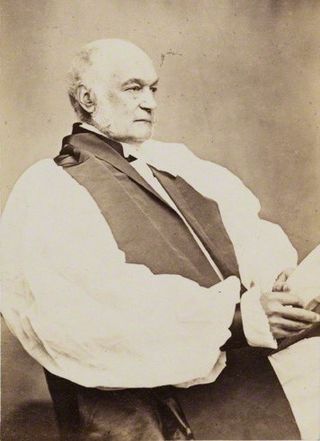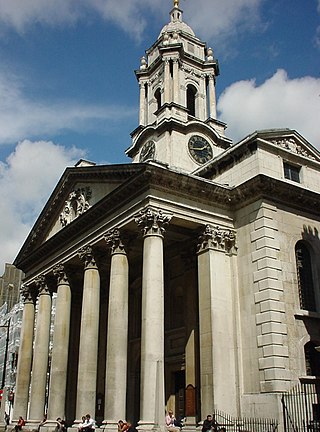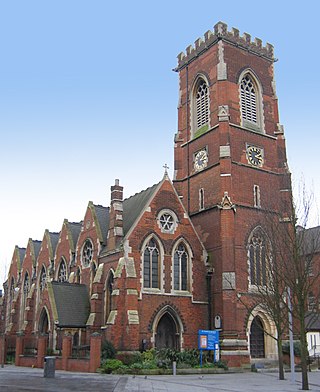
St Peter's Church was an Anglican church in Great Windmill Street in Soho, in the City of Westminster, London. It was built in 1861, and was demolished in the 1950s.

St Peter's Church was an Anglican church in Great Windmill Street in Soho, in the City of Westminster, London. It was built in 1861, and was demolished in the 1950s.
The church was designed by Raphael Brandon, for a small site on the east side of Great Windmill Street, externally only the west front being seen by the public. Since it was a poor district, funds for the site and for the building came from elsewhere, and the largest single contributor was the 14th Earl of Derby. The foundation stone was laid by the Earl of Derby on the 25 June 1860, and the completed church was consecrated on 12 July 1861. Lavers and Barraud provided glass for the east windows of the aisles. A district was assigned to the church on 7 February 1865. [1]
Incumbents included George Wilkinson (later Bishop of Truro and Bishop of St Andrews) from 1867 to 1869, [2] Arthur Mozley from 1869 to 1880, [3] and Henry Alsager Sheringham from 1880 to 1885. [4] The church was often attended by Lord Salisbury. [1]
The building measured 100 by 50 feet (30 by 15 m): it was built of brick and faced inside and out with Bath stone. It had a nave and aisles, with clerestory above, and a short apsidal chancel. [1]
In 1953, a new parish was created, uniting the parishes of St Peter's Church, St Thomas's Church in Regent Street and St Anne's Church, Soho. St Peter's was closed in April 1954, and was demolished. [1] [5]

Soho is an area of the City of Westminster, part of the West End of London. Originally a fashionable district for the aristocracy, it has been one of the main entertainment districts in the capital since the 19th century.

Sir George Gilbert Scott, largely known as Sir Gilbert Scott, was a prolific English Gothic Revival architect, chiefly associated with the design, building and renovation of churches and cathedrals, although he started his career as a leading designer of workhouses. Over 800 buildings were designed or altered by him.

Wardour Street is a street in Soho, City of Westminster, London. It is a one-way street that runs north from Leicester Square, through Chinatown, across Shaftesbury Avenue to Oxford Street. Throughout the 20th century the West End street became a centre for the British film industry and the popular music scene.

St Mary's Church, Barnes, is the parish church of Barnes, formerly in Surrey and now in the London Borough of Richmond upon Thames. It is a Grade II* listed building.

George Moberly was an English cleric who was headmaster of Winchester College, and then served as Bishop of Salisbury from 1869 until his death.

Saint Anne's Church serves in the Church of England the Soho section of London. It was consecrated on 21 March 1686 by Bishop Henry Compton as the parish church of the new civil and ecclesiastical parish of St Anne, created from part of the parish of St Martin in the Fields. The church is under the Deanery of Westminster in the Diocese of London.

St George's, Hanover Square, is an Anglican church, the parish church of Mayfair in the City of Westminster, central London, built in the early eighteenth century as part of a project to build fifty new churches around London. The church was designed by John James; its site was donated by General William Steuart, who laid the first stone in 1721. The building is one small block south of Hanover Square, near Oxford Circus. Because of its location, it has frequently been the venue for society weddings.

The Survey of London is a research project to produce a comprehensive architectural survey of central London and its suburbs, or the area formerly administered by the London County Council. It was founded in 1894 by Charles Robert Ashbee, an Arts-and-Crafts designer, architect and social reformer and was motivated by a desire to record and preserve London's ancient monuments. The first volume was published in 1900, but the completion of the series remains far in the future.

St Mary's Church, Charing Cross Road, was an Anglican church in Charing Cross Road, Westminster, from 1851. The building was formerly the site of an ancient church, called 'The Greek Church', and St Mary's was never fully built, with only the chancel and the north aisle being completed. The structure was demolished in the 1930s.

Hon. Samuel Waldegrave was Bishop of Carlisle from 1860 until his death.
Croxton is a village on the B5026 between Eccleshall and Loggerheads. Population details for the 2011 census can be found under Eccleshall. It is notable for having an old windmill. The village church is called St. Pauls.
James Adey Ogle (1792–1857) was an English physician.

Alexander Luttrell of Dunster Castle, Somerset, was an English politician and land-owner who served as Member of Parliament for his family's pocket borough of Minehead from 1727 until his death. He was the last in the male line of the Luttrell family, which had owned Dunster Castle since 1376.
Ven. Hugh Chambres Jones was a Welsh churchman who was Archdeacon of Essex from 1823 to 1861.

St Mary's Church is a Church of England parish church in Acton in the London Borough of Ealing. The present church, in red brick with stone dressings in a decorated style, was designed by Horace Francis and constructed 1865–1867. The church was listed Grade II in 1981.

Christ Church, Marylebone, also called Christ Church, Lisson Grove, and Christ Church, Cosway Street, is a Grade II* listed former Church of England church, built in the 1820s in Marylebone in the City of Westminster to designs by Thomas and Philip Hardwick.
St Thomas's Church, also known as Tenison Chapel, was an Anglican church in Regent Street, London. It was built in 1702, on the site of a wooden chapel of 1688; it was a proprietary chapel until 1869, when it became a district church dedicated to St Thomas. It closed in 1954, and was later demolished.
St Luke's Church was an Anglican church in Berwick Street, in the City of Westminster, London. It was built in 1839, on the site of a Huguenot church of 1689 and an Anglican chapel of ease of the 18th century. It was demolished in 1936.